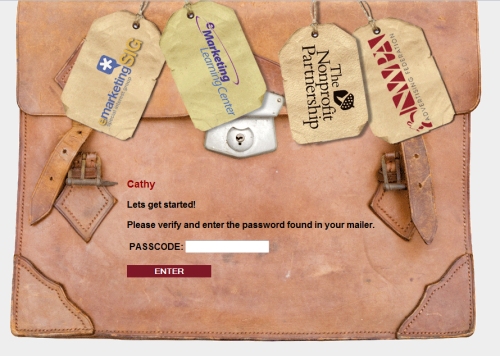
Joe Mehl presents on the topic of PURL
Attendees got personal with PURL at the Manufacturers Association on February 19th when Joe Mehl of Dispatch and George Sackandy of Intelmarx spoke about the benefits of combining PURL with traditional direct mail marketing. But let’s not jump into the benefits until we uncover what PURL is and how it even works.
What is PURL?
PURL, also known as a Personal URL, is a Web page address that has been personalized to a specific recipient using their name. The idea being that a person is more likely to visit a Web page that is personalized with their name in the URL out of curiosity of what information is there. Once they go to that web address, the information is tailored specifically to them based on data the organization already has on file. For example, women may see more humanistic language and images verses a man who would see more competitive/methodical content.
How does it work?
According to Joe Mehl from the seminar, these are the steps taken in the PURL process:
- Contact receives a direct mail or e-mail message describing an offer enticing them to visit their PURL (ex. http://www.gettingpersonal.com/CathySmith)
- The welcome screen on the web page is directed to the recipient using their name

An example of a Welcome Screen
- A contact information page is pre-populated with any data that may already exist and is relevant to the offer
- The prospect is asked to complete a short survey probing them for more information

An example of a survey page
- A marketing message or offer is given
- A thank you page appears providing other links and downloads to the viewer
- Follow up happens immediately whether it is an e-mail or a phone call
- Now the sales process on this individual can begin
Okay, now that we have figured out what PURL is and how it works, it is time to look at how PURLs can be beneficial.
Why use a PURL?
According to George Sackandy, CEO and Founder of Intelmarx, the direct mail industry has a response rate of only 2 percent. This means that the non-response rate is 98 percent! We receive thousands of marketing messages each day and only respond to few and far between. So, how do marketers grab the attention of their prospects? They use PURL in combination with mailing pieces to attract customers!
One case study conducted at Albertson College proved that by incorporating PURLs and variable data printing in their recruiting materials, the school could increase their response rate by 18.7 percent. The school was originally sending large packets of information about every program to all prospective students. This was a lot of information to juggle through and not personal in any way to the person opening it. Prospective students were not responding because the packet looked just like all of the others they had received from other colleges. Albertson decided to get personal. They used information that had already existed about prospects in order to send them a direct mail piece including a PURL. When students went to their PURL, the page was catered to the individual based on their interests, activities, and future major of choice. Albertson took a few extra steps to change their recruiting using PURLs and what a difference it made. Now this gives plenty of reason to use PURLs in any marketing campaign! By using PURL you can increase response rates, leads, and overall profit. Why not give it a try for your business?
For more information on Intelmarx click here
For more information on Dispatch click here






 Become an
Become an 





